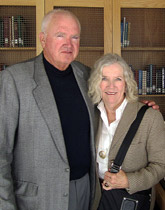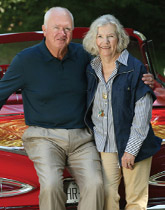
Wilton Scott squints into the bright New Mexico sun. Beside him is his five-year-old son, Sherman, who looks up at his father expectantly. Like many young boys, Sherman loves machines; and, today, he and his father are headed toward a really big one. In front of them, stretching toward the sky, is a drilling rig. They can hear the roar and smell the acrid air as the drilling rotary turns the bit.
Sherman’s father is a geologist, and he loves the life—the travel, the excitement of exploration—all in the hunt for oil and gas. It’s 1949, and New Mexican drilling is booming. Wilton, 36, was born one state away on his grandparents’ Texas farm and raised nearby. As an adult, he followed the oil to New Mexico, married, and started his own family. The oldest is Sherman. Back home on this day is Sherman’s younger sister, Susan, and his mother, Loradean. Wilton knows how much his son loves tagging along to see the rigs and he, in turn, enjoys exposing Sherman to the “real world.”
Of course, there are also times that Wilton is away for weeks on drilling locations, where he will analyze samples that, ideally, will divulge precious clues to what lies beneath the surface. Naturally, Sherman misses his father, but the Scott household runs smoothly, thanks to his mother.
When Sherman gets older, his father starts to include him in a number of other outings, acquainting him with both the world of oil and gas production and the larger world of business. One of Sherman’s favorite activities is oil-rig fishing—a little-known pastime popular with energy insiders. Apparently, an offshore oil rig provides shelter for fish in otherwise open water, and the resulting ‘reef’ provides a bonanza for deep sea enthusiasts. While Sherman enjoys the sport, he’s also becoming even more familiar and comfortable with the massive offshore structures.
More than a half-century later, those days haven’t been forgotten. “I grew up in the oil and gas business at my father’s knee, and I was fortunate that he always exposed me to what he was doing,” recalls Sherman. “You couldn’t do it today, of course, because regulation would preclude it, but it gave me a true appreciation for the efforts undertaken to discover and produce oil and gas.”
When Sherman is 11 years old, his father decides to relocate the family, which now includes a third child, Sarah. The Scotts return to Wilton’s home state of Texas, where he can begin a position with Tenneco, an oil and gas production company. Although Wilton has an adventurous spirit and “probably would have been a great entrepreneur” according to his son, nothing is more important to him than being a consistent breadwinner for his family. Perhaps it’s because he was a child of the Great Depression; he finds peace of mind in the financial security a corporate life can provide. So, the family settles in Houston for Sherman’s formative years.
In school, he develops a love for math and science, particularly chemistry. And when the time comes to consider college, he is pragmatic, just like his father. He wants an education that can translate into solid employment. With Wilton’s encouragement, he decides to study chemical engineering at a “top-notch” school—Carnegie Tech. And there’s an added bonus. “Having grown up in the southwest I was interested in doing some exploration of what I thought was the east coast. When I got to Pittsburgh, though, I found out that most people thought they were out west!” Sherman says now with a chuckle.
While Sherman Scott is charting his future, Joyce Bowie, 1,400 miles away, is doing the same thing. Bowie is from Sharon, a small Pennsylvania town on the Ohio border, where heading to Cleveland is a trip to “the big city.” She knows she’ll be an artist—it’s what she’s always been. The family regularly attends theater, and her mother, an amateur musician, delights in telling the tale of two-year-old Joyce, intent at her small table, crayons in hand. Talented Aunt Dena adored attending nearby Carnegie Tech as a drama major and it seems natural for Joyce to enroll there as a printing and design major.
It’s just as natural when Joyce and Sherman meet on campus. In the true spirit of Carnegie Mellon, call it the perfect marriage of technological-problem-solving and creativity—the ideal “balance of energies,” as Joyce notes. The couple’s courtship doesn’t end when they earn their degrees. Not long after graduating, they marry in 1966 and begin life together in Oklahoma, where Sherman has accepted a job with Phillips Petroleum. For Joyce, it’s a new reality. “It was June and my first time south, really, other than traveling a little bit to relatives in North Carolina, which was south for me. I think it was about 103 degrees. Like being on another planet.”

But thankfully, new beginnings can also be exciting, and Joyce quickly adjusts. As Sherman finds his own place in the energy arena, Joyce enjoys museum curating and teaching when she’s not busy creating her own pieces. There’s just one problem. “From an early age,” says Sherman, “I was interested in doing something independent of the large corporate environment,” echoing the exploring bent of his father. Although the elder Scott went on to have a successful career, his son believes he can best fulfill his own potential through “direct ownership of my efforts,” in part, he says, because of the Carnegie Mellon entrepreneurial culture, which strengthened that resolve.
Sherman tells his wife that he wants to strike out on his own even though it has only been two years since they graduated from college. Better to chance it now, than after a 15-year career, he tells her. “I learned early in my business career that taking risks is a necessary and good thing. I also learned that you don’t want to undertake risks you cannot afford to lose.” If things don’t work out and he should fail, Sherman feels certain that his CMU engineering degree will provide a cushion—someone will hire him. Amazingly, Joyce is thrilled with her husband’s bold plan. “I’m an artist, and this was a medium that is really his. I respect that greatly, so I was all for it.”
Sherman consults his father, a man Joyce has also come to admire. “He was right around six feet tall,” she says, “But with his presence, you thought he was much bigger.” Wilton is concerned that his son’s ambition may be “a bit aggressive,” but ever the explorer, he can’t deny he is intrigued to see what his son “can come up with.”
So, Sherman gets to work identifying a niche; with Wilton’s guidance, he stays close to his roots. “I seized upon doing something in support of offshore oil and gas drilling, because I perceived at that time—1968—that there would be a lot of growth in that part of the energy field,” say Sherman. On that hunch, he and Joyce move to Morgan City, Louisiana, a port city and operations base for offshore activity. He founds a company, Delmar Systems, which specializes in providing mooring services for floating offshore rigs.
A regimen of ten-hour days, six-days-a-week begins for Sherman. It turns out that his intuition proves dead on. The company flourishes. So does the Scott family, which soon includes children Laura, Shaesby, and Andrew. Both the family and Delmar headquarters eventually settle 60 miles up the road in Lafayette, a town where the Scotts can enjoy the close community and academic atmosphere provided by the local university. Delmar Systems grows to encompass operations from the Gulf of Mexico to around the world.
Although they’ve been far from Pittsburgh, both Sherman and Joyce retain a connection to their alma mater. They share an appreciation for their CMU years and all that the education has given them—a “very precious time,” as Joyce says. She remains a working artist, focused on painting and print-making. And Sherman finds that the “Carnegie plan, the focus on the ability to solve problems,” is instrumental in his success. When their children are older, Joyce becomes a trustee, representing the couple’s mutual interest in supporting the university. They maintain that support through the years in many ways, “particularly inspired by the efforts of President Jared Cohon,” as Sherman notes. He recognizes in the CMU leader a certain similarity to his father. “Jerry could have had a very happy career as an engineering professor, but he was willing to undertake the management of a major university. It’s quite a demanding task and one that he’s excelled at. We all get to realize the benefits.”
So when Cohon requests Sherman’s involvement as an expert advisor for a groundbreaking energy institute, Sherman doesn’t hesitate. Happy to bring the “perspective of traditional hydrocarbon fuels to the discussion,” he participates on both Cohon’s advising committee and in larger ‘summit’ conferences, where leaders from industry, academia, and government come together to determine Carnegie Mellon’s best role in leading the way to a sustainable energy future.
“I don’t think that anyone would argue about the need to have ultimate sustainability and to try to minimize the impact on the environment of the use of energy,” Scott says about the critical need for such an institute. “It’s important that we recognize that energy is a principal driving force of our economy and our modern way of life.”
He is inspired by Cohon’s enthusiasm for applying CMU’s systems approach in the energy arena, bringing together the university’s many disciplines to bring about innovative results. He is particularly excited by the concept of bringing technology to bear on improving efficiency.

“It would be a mistake to make energy too limited and expensive,” he says. “We need to make it more efficient and sustainable. One opportunity for the energy institute is promoting efficiency across the entire range of energy use—something that can be done immediately and with existing technology just applied in a reasonable fashion. Jerry likes to speak about a systems approach, and I think it’s particularly applicable on the efficiency front. Carnegie Mellon has many disciplines that can bring some real advancement there.”
The Scotts are also aware that the university is seeking support for the powerful new venture, as well as for a state-of-the-art building that will house the institute. As discussions progress, they make an important decision. They will increase their already significant support for the university with a lead gift to these new efforts. In so doing, they will enable both the new institute’s goal of improving the world’s energy future and Carnegie Mellon’s ability to provide meaningful education.

Joyce is contributing to the design of the new building and is particularly enamored by its proposed location beside Hamerschlag Hall. She sees it as a mix of art and technology—which best represents who they are as well as CMU—with the innovative engineering building “looking at” the Carnegie Museum of Art.
The Scotts make another significant decision—one with great personal meaning. They will name the institute in honor of a leader in the energy field: Wilton Scott, who passed away in 2005. While the elder Scott witnessed his son’s entrepreneurial success, he, too, had great success—climbing the corporate ladder to reach the top of Tenneco, becoming chairman and CEO of the large multinational corporation. What better way to memorialize his life, says his son, than with a vehicle for growth and progress in the energy arena.
“Wilton Scott was a role model for our family, a tremendously strong person and leader, a wonderful man,” says Joyce. “His guidance has given us the ability to do this.”
“Like everyone else, I have become aware over time that whatever we do has impact on the planet,” adds Sherman. “Energy is a precious resource, and the institute is very important to what needs to be achieved in its production and consumption. Carnegie Mellon can absolutely be a leader, no question. And we’re delighted to provide some support for that effort.”
Melissa Silmore (TPR’85) also wrote the accompanying cover story in this issue.



